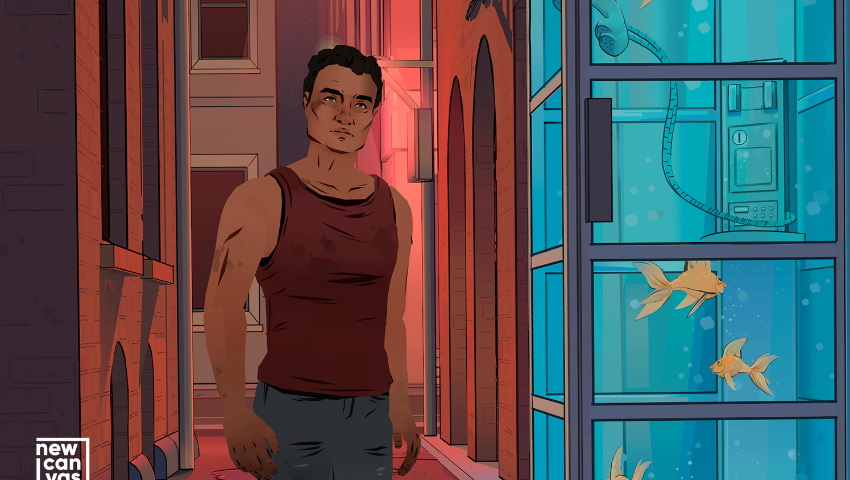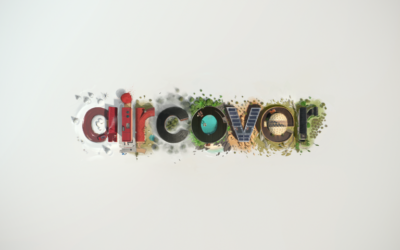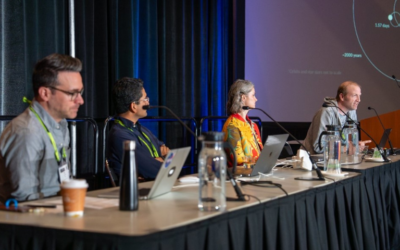Image Credit: (C) 2022 New Canvas
Still not over SIGGRAPH’s 50th conference? That’s OK, we aren’t either! We had the chance to catch up with Nathan Anderson, one of the producers of “Lustration,” a series that was showcased at the celebratory SIGGRAPH 2023 VR Theater. Enjoy this deep dive with Nathan as we discuss how “Lustration” came to be, how his team overcame some challenges along the way, and advice for future VR Theater contributors.
SIGGRAPH: What was the inspiration behind this animated series? What inspired you to pursue a VR experience?
Nathan Anderson (NCA): The inspiration for the series is driven by the writer and director Ryan Griffen. He is really interested in examining the notions of truth in our society — how we collect information, how we assess it, and decide what is right and wrong. As with all good fantasy/drama, we are looking at our current world through an abstract lens. As one of the producers of the series, I am personally very interested in how we can engage audiences in an immersive story that provides something richer and deeper than is possible by watching a passive linear experience (viewed through a rectangle).
SIGGRAPH: Can you share any design or technical choices you made that make “Lustration” unique?
NCA: From a design perspective, we are interested in how we can enable personalization and agency from the audience without interactive mechanics overriding the story. “Lustration” draws some strong influence from live immersive theater (like Sleep No More et al) where a linear story is still being played out, but the audience is free to roam to wherever they want to experience it and, therefore, have a unique and personalized version of the narrative. We are happy with how this design choice has developed through the series and are looking to explore this further in future seasons of “Lustration.”
SIGGRAPH: Were there any barriers you encountered during this process? Whether that’d be the writing or bringing the story to life in virtual reality? If so, how did you overcome those challenges?
NCA: We produced season 1 of “Lustration” within an animated toolset and framework called Quill. This presented some great opportunities for quick iteration and having our creative team be able to view environments and scenes as they were developed by our artists (in VR), but we also had some barriers with the scene lengths and amount of data we could include in each episode. We hence had to limit the episodes to 7–8 minutes each, which was shorter than we wanted. For our second season (which we are in development on now), we are looking to take a similar artistic approach but migrate the assets into Unreal Engine to give us longer episodes, with more functionality and advanced animation.
SIGGRAPH: What advice do you have for those planning to submit to the SIGGRAPH 2024 VR Theater?
NCA: Be bold and ambitious. We are in an era of exploration and experimentation right now in VR storytelling, so it is time to take risks and try new things. We are similar to the TV industry in the 1950s and cinema in the early 20th century. There are no rules and no conventions, just lots of potential. Make sure you push your project as far as you can, both creatively and technically.
SIGGRAPH: What does the future hold for VR? Has “Lustration” played a role in the advancement of VR?
NCA: I am not sure how “Lustration” has played a role in the advancement of VR, but I hope it has inspired some folks to think differently about how to approach narrative in an interactive and spatial environment. I am very positive about the future of VR but also super aware that we still have some years to go before we can break into the mainstream. These years will need the inevitable technological updates but also the content formats and creative experimentation to find the unique and compelling voice for VR. This is a slightly chaotic and challenging time but an extremely exciting one, and I can’t wait to see how it all comes together.
Feeling inspired after reading this blog? Be sure to take advantage of Nathan’s advice and be bold and ambitious as you submit your immersive story for a chance to be showcased in the SIGGRAPH 2024 VR Theater. Submissions are due by 21 February.

Nathan Anderson’s dual expertise in film production and creative technology allows him a forward-looking approach to the evolving media landscape. He brings a futurist mentality to the XR industry, embracing immersive technology as a tool for emotionally resonant narrative storytelling. After beginning his career in the film industry, working on films such as “The Matrix” and “Paradise Road,” Nathan followed the dot-com explosion in the late ’90s, making a transition into digital. In 1999, at the age of 25, he co-founded a tech startup that generated over 10m unique users per month and successfully raised venture capital. Nathan leveraged this tech and media experience to dive into multiplatform digital development and transmedia content creation. Nathan has produced content for all digital platforms, working with top international brands and companies, such as Foxtel, Disney, Viacom, ABC, BBC, and NBCUniversal. Active in the XR industry since 2015, Nathan has produced and EP’d over 50 XR projects, including critically acclaimed and awarded projects such as “Lustration,” “Wentworth VR,” “Awake: Episode One,” and “VR Noir.” His latest venture, New Canvas, continues this focus on entertainment content in the immersive media industry. Nathan is a member of the Producers Guild of America and is on the Industry Advisory Panel with AFTRS. In 2021, Nathan was elected a Councillor of Screen Producers Australia. He is a regular speaker at industry conferences and graduated with a BA comms from the University of Canberra and a MA by research exploring interactive narrative from AFTRS.



